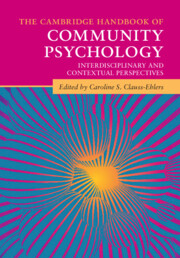Book contents
- The Cambridge Handbook of Community Psychology
- The Cambridge Handbook of Community Psychology
- Copyright page
- Dedication
- Contents
- Figures
- Tables
- Contributors
- Foreword
- Part I Foundational Concepts
- Part II Research, Assessment, and Program Evaluation
- Part III Community Psychology in Action
- 10 Women and Leadership
- 11 Community Resilience
- 12 Building Community Resilience and Supporting Disaster Risk Reduction through Social Action Efforts
- 13 The Consumer Recovery Movement in the United States
- 14 Taking Back the Streets
- 15 Promoting Adolescent Mental Health
- 16 Gowanus Canal and Public Policy
- 17 Family Support Services at Ronald McDonald House Promotes Healing of Seriously Ill Children
- 18 Community Psychology and a Fresh Look at Faith Healing Camps
- 19 Community Impact of Social Media
- 20 Supporting Communities through Educational Access
- 21 Psychological Impact of Climate Change on Communities
- 22 Optimal Local Government and Public Service Provision
- 23 A Public Health Approach to Delinquency and Incarceration
- 24 Public Service Organizations and Community Empowerment
- 25 Women and Immigration
- 26 Community-Based Transition Interventions for Adolescents and Young Adults with Neurodevelopmental Disabilities
- 27 Mental Health on College Campuses
- 28 LGBTQ+ Communities
- Part IV Where Do We Go from Here?
- Index
- References
11 - Community Resilience
From Broken Windows to Busy Streets
from Part III - Community Psychology in Action
Published online by Cambridge University Press: 16 December 2021
- The Cambridge Handbook of Community Psychology
- The Cambridge Handbook of Community Psychology
- Copyright page
- Dedication
- Contents
- Figures
- Tables
- Contributors
- Foreword
- Part I Foundational Concepts
- Part II Research, Assessment, and Program Evaluation
- Part III Community Psychology in Action
- 10 Women and Leadership
- 11 Community Resilience
- 12 Building Community Resilience and Supporting Disaster Risk Reduction through Social Action Efforts
- 13 The Consumer Recovery Movement in the United States
- 14 Taking Back the Streets
- 15 Promoting Adolescent Mental Health
- 16 Gowanus Canal and Public Policy
- 17 Family Support Services at Ronald McDonald House Promotes Healing of Seriously Ill Children
- 18 Community Psychology and a Fresh Look at Faith Healing Camps
- 19 Community Impact of Social Media
- 20 Supporting Communities through Educational Access
- 21 Psychological Impact of Climate Change on Communities
- 22 Optimal Local Government and Public Service Provision
- 23 A Public Health Approach to Delinquency and Incarceration
- 24 Public Service Organizations and Community Empowerment
- 25 Women and Immigration
- 26 Community-Based Transition Interventions for Adolescents and Young Adults with Neurodevelopmental Disabilities
- 27 Mental Health on College Campuses
- 28 LGBTQ+ Communities
- Part IV Where Do We Go from Here?
- Index
- References
Summary
The basic components of Resiliency Theory – risk exposure, promotive assets and resources, and the dynamic interaction of risk and promotive factors over time – can be applied to the study of community well-being when communities face challenges. Although community well-being is often studied relative to acute risks, such as a natural disaster, it can also be threatened by chronic risks. Chronic risk exposure for a community includes factors such as economic decline, property vacancy, and crime. Over time these risks become additive in nature and interact with one another to adversely affect individuals, families, neighborhoods, and even entire cities. Economic decline of a given area, for example, can result in neighborhood instability and disadvantage that results in greater risk of crime. We argue that communities exposed to chronic stressors over time face slow disasters. Slow disasters create vulnerability and increase susceptibility to risk factors that generate barriers to community health and well-being. We apply these ideas through a case study of the postindustrial city of Flint, Michigan and discuss possible mechanisms to enhance resiliency in the face of slow disaster to achieve community well-being.
Keywords
- Type
- Chapter
- Information
- The Cambridge Handbook of Community PsychologyInterdisciplinary and Contextual Perspectives, pp. 223 - 247Publisher: Cambridge University PressPrint publication year: 2021
References
- 1
- Cited by

